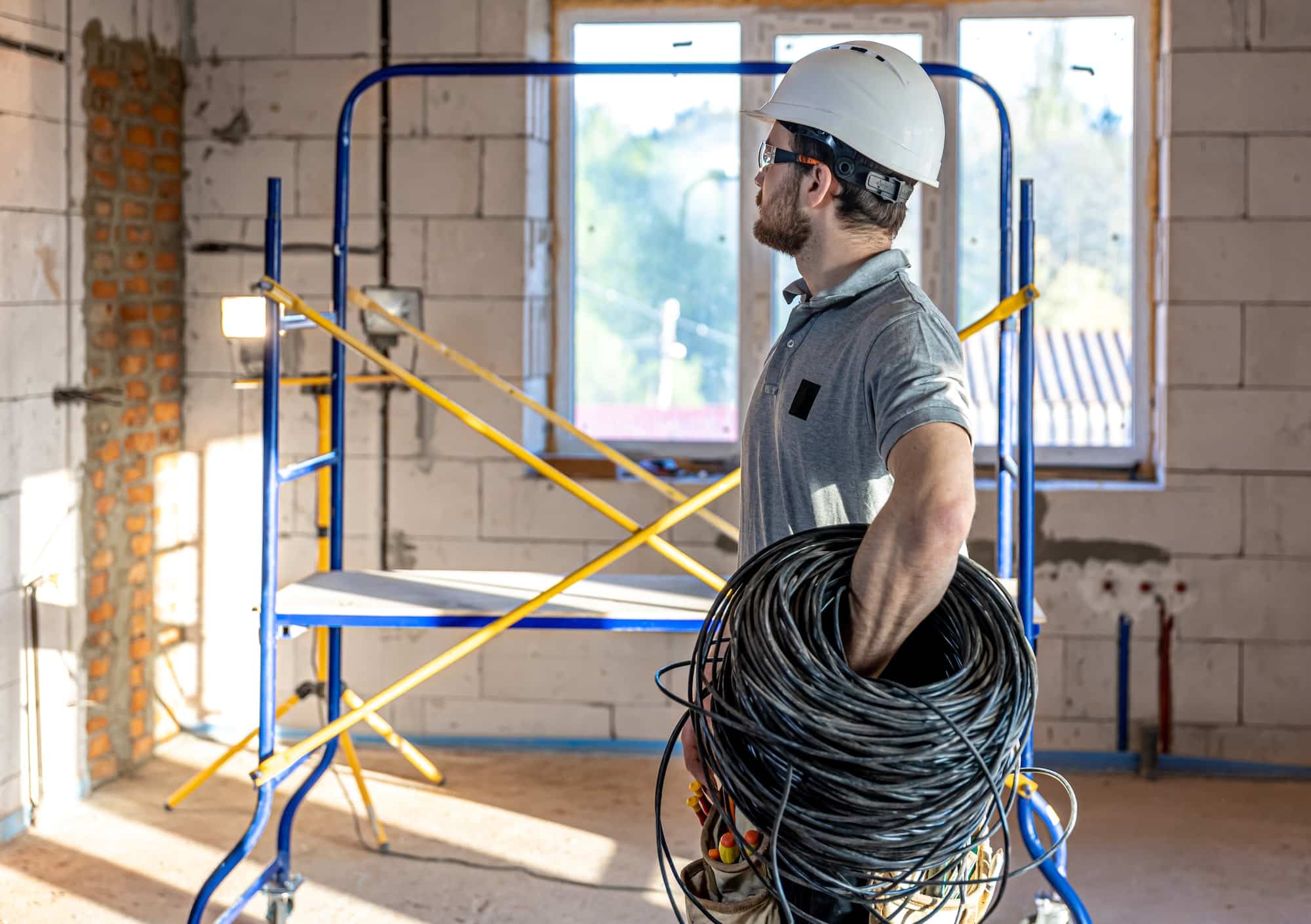The framing is built, the plumbing is in, and now you're getting ready for the next big step in your new construction project – electrical work. You might wonder, "How much could running wires really cost?" From lighting to Internet cables and everything in between, installing all the necessary electrical wiring throughout a new construction project is one of the most important steps.
Electrical work is more than a DIY project. You need licensed electricians to ensure the job is completed correctly and complies with all codes and regulations, especially in a new build. At Suncoast Power, we believe transparency is key, so we included a list of potential charges so you know everything involved when calculating your total electrical costs.

How is Electrical Wiring Installed?
Installing new construction wiring is done before the walls and flooring are put in. Electricians will drill a series of three-quarter-inch holes through a run of studs or joists. It’s important that the holes are drilled in the center of the studs to ensure a secure hold of the wires.
Electricians will then secure the cable-run by stapling or supporting it with straps every four-and-a-half feet to avoid movement.
General Electrical Work Cost Factors
It may seem daunting to think through all the electrical costs involved with your project, but don’t worry; we understand what goes into electrical work and what will influence your overall budget. Electrical pricing varies from project to project. However, these three factors will contribute to the total cost across the board:
- Certifiable vs. Generic Brand Materials. Materials from certifiable brands (like Hubbell and Belden) usually last longer and come with better warranties. Generic brands are cheaper, but you could pay more for maintenance, replacement, and electrical damage in the long run.
- Location: Building a new high-rise in a smaller suburban or rural area will cost significantly less than the same building in an urban setting. The location of your construction projects heavily influences the cost of labor and materials.
- Independent Contractors vs. Large-company Electricians. Anyone can run a wire through a tube or along ceiling rafters. But you’ll want a well-trained, highly qualified electrician to complete the wiring work. Big-brand electricians typically charge more than independent contractors because of their larger overhead.
The Three Electrical Wiring Methods
Safety, efficiency, and accessibility are three major considerations for electrical wiring installation. An equally significant factor is pricing. Electricians can help you think through all these factors to determine which wiring method will work best.
Raceways and Conductors
The first (and perhaps most common) method of electrical wiring involves raceways and conductors. Conductors generate electricity and enable it to flow through aluminum or copper wire. Raceways protect the cables with nonmetallic or metallic conduits, ensuring they don’t get damaged or create safety hazards.
The most popular conductors are:
- Thermoplastic high-heat-resistant or water-resistant
- Nylon-coated wires (THHN/THWN) or thermoset-insulated
- High-heat-and-water-resistant wires (XHHW).
Raceways also come in various types, including:
- Rigid metal conduit (RMC)
- Intermediate metal conduit (IMC)
- Flexible metal conduit (FMC)
- Electrical metallic tubing (EMT)
- Polyvinyl chloride conduit (PVC)
The raceway and conductor method has several pros and cons. In terms of cost, though, installation is usually expensive.
Busways
Busways offer another excellent solution to wiring. These metal-encased raceways are more compact than other conduits and provide a wide range of available amperage, adding flexibility to your electrical system. However, busways require many different joints and offsets, making this method rather expensive.
Cable Assemblies
Cable assemblies are the third option for electrical wiring. These applications have several conductors with customizable options to suit your unique project. Cable assemblies typically have the lowest installation costs and come in the following types:
- Armored (AC)
- Metal-clad (MC)
- Metal-sheathed, Material-insulated (MI)
- Nonmetal-sheathed (NM, NMS, and NMC)
- Underground feeder (UF)
Four Main Types of Electrical Wiring Used
When it comes to electrical wiring, there are several options to choose from. Each has slightly different construction, and electricians will decide which to install during the electrical work to best fulfill your requirements and needs.
Metal-Clad Wires (Type MC)
If you see electrical wiring in a commercial facility, it’s probably MC Type. Metal clad wiring is highly versatile and works well in many places besides commercial buildings. MC Type uses a network of aluminum armor to protect the inner wiring, making it corrosion-resistant and heat and moisture tolerant.
Armored-Clad Wires (Type AC)
Type AC wiring provides safety and durability. It includes a similar protective aluminum covering with the added support of a messenger wire. Because of their durability features, Type AC wiring can be installed underground or in areas exposed to the elements. It’s important to note that these wires can’t be used in structures taller than three stories high.
Mineral-Insulated/Metal-Sheathed Wires (Type MI)
Mineral-insulated wires don’t damage easily due to their continuous copper sheath, which acts as an extra protective layer. Type MI wires also serve as a grounding conductor for equipment. This type of wire also functions well for emergency systems and more elaborate projects.
Underground Feeder Wires (Type UF)
This flexible wiring doesn’t require much space and stays out of sight by running through the walls. It’s specifically designed for wet locations and direct ground installation. UF wiring includes a PVC-enclosed THWN wire, making them the perfect choice for outdoor fixtures.
Special Commercial Wiring Classes To Consider
Commercial buildings often use a lot of power throughout the workday, sometimes 24/7. Such a demanding workload requires a robust electrical system. Three different wiring classes can provide this high-voltage demand in commercial areas.
Type I Wiring
Type I wiring (or conduit wiring) involves underground PVC- or metal-enclosed electrical wires. This type of wiring, used globally, is highly durable and long-lasting.
Type II Wiring
Many types of electrical wiring run out of sight behind walls or ceiling panels. However, Type II cables will go through a trunking system on your commercial building’s surface. These wires are popular among the automation and lighting industries because of their lower safety protection requirements.
Type III Wiring
Type III wiring works much like Type II wiring, offering a higher voltage output than other wiring classes. Class III wires require a voltage rating of not less than 300 volts and a temperature rating no lower than 140 degrees Fahrenheit.
Electrical Wiring Cost by System Type
Before electrical work, an electrician will determine which wiring system to install. Lead-sheathed and conduit wiring are the two most common system types. You can expect to pay about the same for both, but each has slightly different advantages.
Lead-Sheathed Wiring
If your building contains high-moisture areas, lead-sheathed wiring is probably your best option. This sheathing protects the inner wire from damage in damp, humid environments, even when directly exposed. Lead-sheathed wiring costs $3–$5 per square foot to install.
Conduit Wiring
Conduit wiring involves running wires through tubing either on the building’s surface or hidden along the framework. These long-lasting conduits won’t affect your interior aesthetic, and you can also expect to pay $3–5 per square foot.
Electrical Wire Price by Material
As you calculate the total costs for electrical work, you’ll need to consider wiring material. Some materials work better in certain buildings, and prices vary considerably. Some of the most common cable materials, their main features, and their price ranges per linear foot include:
Multi-Conductor Cable
- Mainly used for audio-visual setups and security systems
- Price range: $3–5
Shielded Twisted Pair Cable
- Designed for CCTV cameras, phones, and other audio-visual equipment
- Usually not found in newer homes
- Price range: $0.20–$0.35
Coaxial Cable Cost
- Designed for TV and Internet hookups
- Less popular now due to emerging smart home technology
- Price range: $0.25–$0.35
Direct Buried Cable
- Uninsulated, underground coaxial cable
- Designed for cable TV and high-speed Internet
- Difficult to access but highly durable
- Price range: $0.40–$0.50
Metallic Sheathed Cable
- Also called AC or BX cables
- Easy to install, repair, and maintain
- Excellent functionality in various locations
- Price range: $0.50–$0.70
Underground Feeder Cable
- Durable, discreet underground wiring
- Waterproof, plastic-encased wire bundles
- Typically designed for exterior lighting systems
- Connects to circuit breakers
- Price range: $0.50–$0.70
Twin-Lead Cable
- Initially intended for radio and TV transmissions
- Rarely used nowadays
- Price range: $0.60–$0.80
Nonmetallic Sheathed Cable
- An excellent option to replace old metal-sheathed cabling
- More expensive than cables with metallic sheathing
- Price range: $0.60–$0.80
Ribbon Cable
- Low-voltage wire bundles
- Used for office equipment like computers and printers
- Not connected to main power supplies
- Price range: $1.50–$2
Electrical Work Costs by Project
A new construction project often requires extensive electrical work. It involves more than installing wires—you’ll need light fixtures, switches, Internet cables, and electrical outlets. Each project has its own price range, making calculating pricing difficult to predict.
Wiring Installation
You’ll want to install electrical wires correctly and safely, ensuring efficient power flow throughout the structure. Wiring installation can cost a pretty penny, but your building won’t function without it. Some cost averages to give you a picture of what you can expect when it’s time for your wiring project are:
- Average Cost: $8,000
- Average Price Range: $4,000–$10,000
- Lower-end Cost: $1,500
- Higher-end Cost: $30,000
Light Fixture Installation
No construction project is complete until you have adequate lighting. Light fixture installation costs vary greatly. You can expect to spend anywhere from $50 to $1,200. Installing cheaper light fixtures will cost closer to $50, while luxury lamps and chandeliers will cost $1,200 and above.
Light Switch Installation
You can’t have a light fixture without a light switch. Light switches enable you to turn on and off lighting in the room, and a qualified electrician can install them safely in convenient places. Your costs for light switch installation will vary depending on size and type. Generally, you can expect the following prices:
- Single-pole Toggle Switches: $150–$220
- Three-way Toggle Switches: $175–$250
- Replacement Light Switches: $80–$120
Electrical Outlet Installation
Electrical outlets are essential in every residential, commercial, and industrial building. Without them, you won’t be able to plug in essential appliances. When calculating electrical work costs on a new construction project, you’ll need to factor in outlet installation.
Outlets can be inside or outside the building. Here’s a rundown of installation costs based on location:
- Standard Interior Outlets: $140–$165
- Split Interior Outlets: $190–$275
- Covered Exterior Outlets: $200–$275
- Replacement Interior and Exterior Outlets: $120–$150
Internet Wiring Installation
In today’s technologically advanced world, you’re probably planning on having Internet connectivity in your new build. You’ll need a licensed electrician to install Ethernet cables. Ethernet cable installation can cost hundreds to thousands of dollars, depending on the magnitude of the job.
Additional Electrical Work Costs
Besides the upfront costs to install wiring, light fixtures, cables, etc., you will likely face additional electrical work costs. You’ll want to consider hourly charges, inspection fees, service charges, and generator service fees before finalizing your budget.
Electrician Per Hour Costs
Many factors contribute to an electrician’s hourly charge. Work experience, company worked for, and location are all common factors in determining an electrician’s hourly wage. Licensed electricians typically charge between $50 to $100 per hour.
Two other common factors often contribute to installation fees: simplicity of work and distance from the site.
Simplicity of Work
To calculate hourly costs for electrical work, you’ll want to evaluate the task itself. Does it have lots of moving parts that will require extensive labor? Simple jobs usually cost less than complex ones because they require fewer materials and time.
Distance From Site
Finding a qualified electrician near you is your best option. If an electrician must travel a couple of hours to reach the worksite, they may charge more than clients down the road. You’ll usually save money hiring a local expert instead of someone who must travel long distances to reach you.
Working with a local electrician can also create a beneficial, long-term relationship.
Electrical Inspection Fees
Don’t assume that your expenses end after the electrician leaves. You’ll still need to pay electrical inspection fees, typically around $350, to ensure everything works correctly and meets electrical codes.
Service Charges
Although electricians will give you an estimate before starting work, most of them charge more for their services during the first hour. Make sure you note these service charges as you calculate your total expenses. First-hour service fees can run up to $150, depending on the electrician and project timetable.
Generator Services
Generator services are an additional cost worth considering and can substantially increase your total expenses. You can anticipate $1,000–$6,000 to install a new generator on your property. To repair a broken generator, you’ll likely pay about $250.
Let Us Break Down Your Electrical Work Costs on Your New Construction Project
Although many moving parts are involved during the electrical step of a new construction project, it’s not as alarming as it seems. You need electrical work done right the first time, and with over 30 years of wiring experience, we’ve become Florida’s leading low-voltage wiring company. Suncoast Power specializes in a wide range of electrical installation, upgrades, and maintenance services from Ethernet cabling to surveillance camera wiring.
If it’s time to start electrical work on your new construction project, call our support team at (754) 200-5872 to schedule your electrical work and get the ball rolling on your project!


